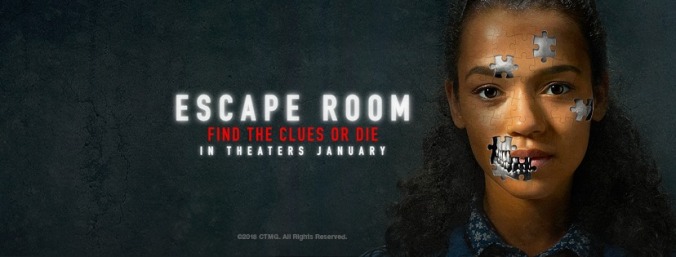No matter how highbrow horror becomes, there will always be room in the genre for good old-fashioned exploitation. Not in a misogynist sense; more like the huckster’s instinct to profit from cultural phenomena by making disposable potboilers about them. In the ’80s and ’90s, this strategy brought us such quaint artifacts as aerobics horror and arcade horror. Now, Sony is ringing in 2019 with Escape Room, a sporadically clever riff on the past-its-prime escape-room trend. Clumsily scripted and extremely predictable, Escape Room absolutely deserves to be unloaded into the cinematic landfill that is early January. That being said, the escape-room scenes themselves (a.k.a. the good stuff) are imaginatively conceived and deftly executed enough to justify a late-night cable viewing.
The film’s premise—six strangers are invited to participate in an escape-room challenge that turns out to have deadly stakes—is straight out of a Hollywood script lab, blending elements of other, more original movies (namely, 1997’s Cube and the Saw series) in hopes of making a quick buck off of name recognition. The film’s character development follows a similarly lackadaisical path, sticking to one-dimensional traits that can be unpacked in 30 seconds or less and picking off its characters in the expected order.
Following a Saw-esque flash-forward opening, the first act introduces three of our six strangers: uptight physics student/obvious final girl Zoey (Taylor Russell), cutthroat businessman Jason (Jay Ellis), and minimum-wage loser Ben (Logan Miller), whose alcoholism is established by a shot of a flask sitting on his desk. (It’s efficient, you have to give them that.) After receiving anonymous packages, each with a Hellraiser-lite puzzle box that spits out invitations to complete an escape room for a $10,000 prize, Zoey, Jason, and Ben all converge on an anonymous office building in a deserted industrial park.
There, they meet three more, previously un-introduced characters—escape-room enthusiast Danny (Nik Dodani), physically and mentally scarred Iraq veteran Amanda (Deborah Ann Woll), and Appalachian truck driver Mike (Tyler Labine)—and the game begins. First is a stylish waiting room outfitted with what are essentially diabolical space heaters, bringing the temperature up to dangerously high levels. The next room replaces fire with ice, and the third brings perilous heights into the equation. By the time we get to the malevolently moralistic psychological torture chamber, it’s clear not only to the audience, but our characters as well, that this game is real, man. And it takes place at the bidding of the favorite faceless threat of 21st-century techno-paranoiacs: Depraved billionaires on the dark web, who have pooled their bottomless resources to create an all-powerful, yet completely clandestine international bloodsport network a lá last year’s Unfriended: Dark Web.
In fact, the main difference between Escape Room and its cluster of influences is its PG-13 rating—which, for once, isn’t really an issue. Director Adam Robitel (The Taking Of Deborah Logan, Insidious: The Last Key) wisely compensates for the lack of gore by focusing on the mechanics of the puzzles themselves, rather than the gruesome consequences of failing to solve them. Some of these mechanics are quite clever, like the jukebox puzzle that’s key to escaping a room consisting of an upside-down bar over a deep elevator shaft whose floor drops out piece by piece at regular intervals. And some of them are a confusing blend of ingenious and idiotic, like the canny Christmas-themed puzzle that reveals that Ben accidentally killed his high school friends in a drunken car crash while singing “Rudolph The Red-Nosed Reindeer.”
Think of it this way: If American Vandal is smart-dumb, bringing a palpable intelligence to ridiculous content, then Escape Room is dumb-smart, putting a boneheaded veneer on imaginative ideas. At a certain point in each of the escape-room scenes, Robitel flips a switch, and gleeful roller-coaster tension floods the remainder of the sequence. Then an especially clunky bit of dialogue or goofy chunk of Brian Tyler and John Carey’s bizarre techno-pop score breaks the spell, and it’s like those slick, breathless moments never happened. Once the January dumping ground blossoms into summer-movie season, the same will probably be said for this movie.


 Keep scrolling for more great stories from A.V. Club.
Keep scrolling for more great stories from A.V. Club.